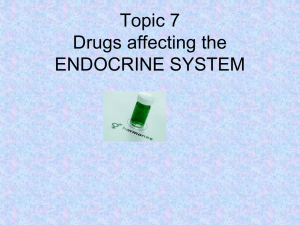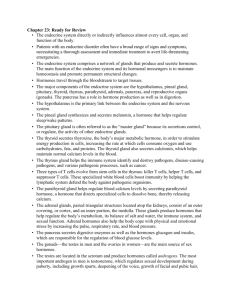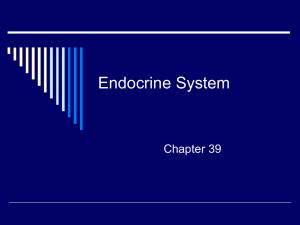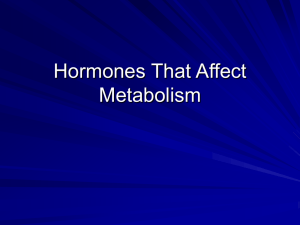42.1 Endocrine Glands The endocrine system functions differently
advertisement
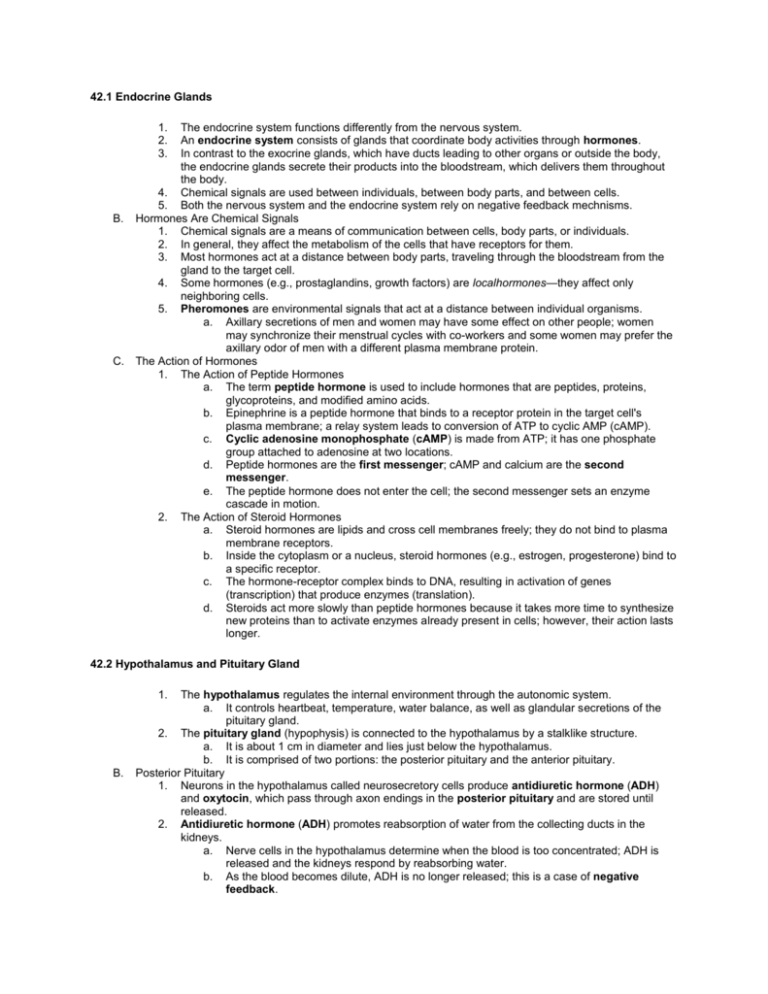
42.1 Endocrine Glands 1. 2. 3. B. C. The endocrine system functions differently from the nervous system. An endocrine system consists of glands that coordinate body activities through hormones. In contrast to the exocrine glands, which have ducts leading to other organs or outside the body, the endocrine glands secrete their products into the bloodstream, which delivers them throughout the body. 4. Chemical signals are used between individuals, between body parts, and between cells. 5. Both the nervous system and the endocrine system rely on negative feedback mechnisms. Hormones Are Chemical Signals 1. Chemical signals are a means of communication between cells, body parts, or individuals. 2. In general, they affect the metabolism of the cells that have receptors for them. 3. Most hormones act at a distance between body parts, traveling through the bloodstream from the gland to the target cell. 4. Some hormones (e.g., prostaglandins, growth factors) are localhormones—they affect only neighboring cells. 5. Pheromones are environmental signals that act at a distance between individual organisms. a. Axillary secretions of men and women may have some effect on other people; women may synchronize their menstrual cycles with co-workers and some women may prefer the axillary odor of men with a different plasma membrane protein. The Action of Hormones 1. The Action of Peptide Hormones a. The term peptide hormone is used to include hormones that are peptides, proteins, glycoproteins, and modified amino acids. b. Epinephrine is a peptide hormone that binds to a receptor protein in the target cell's plasma membrane; a relay system leads to conversion of ATP to cyclic AMP (cAMP). c. Cyclic adenosine monophosphate (cAMP) is made from ATP; it has one phosphate group attached to adenosine at two locations. d. Peptide hormones are the first messenger; cAMP and calcium are the second messenger. e. The peptide hormone does not enter the cell; the second messenger sets an enzyme cascade in motion. 2. The Action of Steroid Hormones a. Steroid hormones are lipids and cross cell membranes freely; they do not bind to plasma membrane receptors. b. Inside the cytoplasm or a nucleus, steroid hormones (e.g., estrogen, progesterone) bind to a specific receptor. c. The hormone-receptor complex binds to DNA, resulting in activation of genes (transcription) that produce enzymes (translation). d. Steroids act more slowly than peptide hormones because it takes more time to synthesize new proteins than to activate enzymes already present in cells; however, their action lasts longer. 42.2 Hypothalamus and Pituitary Gland 1. B. The hypothalamus regulates the internal environment through the autonomic system. a. It controls heartbeat, temperature, water balance, as well as glandular secretions of the pituitary gland. 2. The pituitary gland (hypophysis) is connected to the hypothalamus by a stalklike structure. a. It is about 1 cm in diameter and lies just below the hypothalamus. b. It is comprised of two portions: the posterior pituitary and the anterior pituitary. Posterior Pituitary 1. Neurons in the hypothalamus called neurosecretory cells produce antidiuretic hormone (ADH) and oxytocin, which pass through axon endings in the posterior pituitary and are stored until released. 2. Antidiuretic hormone (ADH) promotes reabsorption of water from the collecting ducts in the kidneys. a. Nerve cells in the hypothalamus determine when the blood is too concentrated; ADH is released and the kidneys respond by reabsorbing water. b. As the blood becomes dilute, ADH is no longer released; this is a case of negative feedback. c. C. Inability to produce ADH causes diabetes insipidus (watery urine), in which the individual produces copious amounts of urine and a resultant loss of ions from the blood. 3. Oxytocin is also made in the hypothalamus and stored in the posterior pituitary. a. Oxytocin stimulates uterine muscle contraction in response to uterine wall nerve impulses. b. It also stimulates the release of milk from mammary glands. c. This positive feedback mechanism increases intensity; such positive feedback does not maintain homeostasis. d. Oxytocin also may play a role in the propulsion of semen through the male reproductive tract. Anterior Pituitary 1. Stimulation by the hypothalamus controls the release of anterior pituitary hormones through a portal system consisting of two capillary systems connected by a vein. 2. The hypothalamus produces hypothalamic-releasing and hypothalamic-inhibiting hormones which pass to the anterior pituitary by this portal system. a. Thyroid-releasing hormones released from the hypothalamus act on cells in the anterior pituitary to stimulate the production and secretion of a specific hormone. b. Thyroid-inhibiting hormones produced in and released from the hypothalamus act on cells in the anterior pituitary to inhibit the production and secretion of a specific hormone. 3. The anterior pituitary produces six different hormones. a. Three of these anterior pituitary hormones affectother glands. i. The thyroid-stimulating hormone (TSH) stimulates the thyroid to produce and secrete thyroxin. ii. Adrenocorticotropic hormone (ACTH) stimulates the adrenal cortex to release cortisol. iii. Gonadotropic hormones (follicle-stimulating hormone [FSH] and luteinizing hormone [LH]) act on the gonads (ovaries and testes) to secrete sex hormones. b. The other three hormones do not affect other glands. i. Prolactin (PRL) is produced in quantity only after childbirth. 1. Prolactin causes the mammary glands to produce milk. 2. It also plays a role in carbohydrate and fat metabolism. ii. Melanocyte-stimulating hormone (MSH) causes skin color changes in fishes, amphibians, and reptiles with melanophores, special skin cells. iii. Growth hormone (GH or somatotropic hormone) 1. GH promotes skeletal and muscular growth. 2. GH acts to stimulate the transport of amino acids into cells and to increase the activity of ribosomes. 3. GH promotes fat metabolism rather than glucose metabolism. 4. Too little GH during childhood makes an individual a pituitary dwarf. 5. Too much forms a giant; life expectancy is less because GH affects blood glucose levels and promotes diabetes mellitus. 6. The overproduction of GH in adults results in acromegaly; since long bone growth is no longer possible, only the feet, hands, and face grow. 42.3 Other Endocrine Glands and Hormones A. Thyroid and Parathyroid Glands 1. The thyroid gland is in the neck and attached to the trachea just below the larynx. 2. The parathyroid glands are embedded in the posterior surface of the thyroid gland. 3. Thyroid Gland a. The thyroid gland is the largest endocrine gland. b. The two hormones produced by the many follicles of the thyroid gland both contain iodine. i. Thyroxine (T4) contains four iodine atoms. ii. Triiodothyronine (T3) contains three iodine atoms. c. Lack of iodine causes enlargement of the thyroid (simple goiter). i. Simple goiter is easily prevented by supplementing iodine intake in salt. d. Thyroid hormones increase the metabolic rate; there is no one target organ—all organs respond. e. Cretinism (congenital hypothyroidism) occurs in individuals who have suffered from low thyroid function since birth. i. Affected individuals are short and stocky and have had hypothyroidism since infancy. ii. B. Thyroid treatment helps but unless it is begun in the first two months, mental retardation can occur. f. Myxedema is hypothyroidism in adults; thyroid hormones can restore normal function. g. Hyperthyroidism (Graves disease) occurs when the thyroid gland is enlarged or overactive. i. The eyes protrude because of edema in the eye socket tissue; this is called exophthalmic goiter. ii. Removal or destruction of some thyroid tissue by surgery or radiation often cures the condition. h. The thyroid gland also produces calcitonin. i. Calcitonin lowers the calcium level in the blood and increases deposits in the bone by reducing osteoclasts. ii. Calcitonin is also necessary for blood clotting. iii. If blood calcium is lowered to normal, the release of calcitonin is inhibited. iv. Too low calcium levels stimulate the release of parathyroid hormone (PTH) by the parathyroid glands. 4. Parathyroid Glands a. Parathyroid glands produce parathyroid hormone (PTH). i. Under the influence of PTH, the calcium level in blood increases and the phosphate level decreases. ii. PTH stimulates the absorption of Ca2+ by activating vitamin D, the retention of Ca2+ (and excretion of phosphate) by the kidneys, and demineralization of bone by promoting the activity of osteoclasts. iii. When the blood calcium level reaches the right level, the parathyroid glands no longer produce PTH. iv. If PTH is not produced in response to low blood Ca2+, tetany results because the Ca2+ plays an important role in both nerve conduction and muscle contraction. b. In tetany, the body shakes from continuous muscle contraction due to the increased excitability of nerves that fire spontaneously and without rest; this condition may be due to hypoparathyroidism. c. In hyperparathyroidism, the abnormally high blood calcium levels can cause the bones to be soft and fragile, and the individual to be prone to kidney stones. Adrenal Glands 1. Two adrenal glands sit atop the kidneys. 2. Each gland consists of two parts: an outer adrenal cortex and an inner adrenal medulla. 3. The cortex and medulla have no physiological connection between them. 4. The hypothalamus exerts control over both portions. a. Nerve impulses travel via the brain stem to the spinal cord to sympathetic nerve fibers to the medulla. b. The hypothalamus uses ACTH-releasing hormone to control the anterior pituitary's secretion of ACTH. 5. Adrenal hormones increase during times of physical and emotional stress. 6. Both epinephrine and norepinephrine are produced by the adrenal medulla. 7. Both hormones bring about body changes corresponding to an emergency. a. The blood glucose level rises and metabolic rate increases. b. The bronchioles dilate and breathing rate increases. c. Blood vessels to the digestive tract and skin constrict; those to the skeletal muscles dilate. d. The cardiac muscle contracts more forcefully and the heart rate increases. 8. The adrenal cortex hormones provide a sustained response to stress. a. The adrenal cortex secretes two types of hormones: glucocorticoids and mineralocorticoids. i. Glucocorticoids help to regulate blood glucose levels. ii. Mineralocorticoids regulate the levels of minerals in the blood. iii. The adrenal cortex also secretes a small amount of both male and female sex hormones in both sexes. 9. Glucocorticoids: Cortisol is a biologically significant glucocorticoid. a. Cortisol promotes the breakdown of muscle protein into amino acids taken up by the liver from the blood. b. Cortisol breaks down fatty acids rather than carbohydrates; cortisol therefore raises blood glucose levels. c. Cortisol counteracts the inflammatory response; it helps medicate arthritis and bursitis. 10. Mineralocorticoids: Aldosterone is the most important of the mineralocorticoids. The primary target organ is the kidney where it promotes the reabsorption of Na + and the excretion of K+. b. Mineralocorticoid secretion is controlled by the renin-angiotensin-aldosterone system i. Under low blood volume and sodium levels, the kidneys secrete renin. ii. The enzyme renin converts the plasma protein angiotensinogen to angiotensin I; this becomes angiotensin II by a converting enzyme in the lungs. iii. Angiotensin II stimulates the adrenal cortex to release aldosterone. iv. Angiotensin I constricts the arterioles directly; aldosterone causes the kidneys to absorb calcium. v. When the blood sodium rises, water is reabsorbed as the hypothalamus secretes ADH; blood pressure then increases to normal. c. Atrial natriuretic hormone (ANH) causes the excretion of sodium. i. When the atria of the heart are stretched due to increased blood volume, cardiac cells release ANH. ii. ANH inhibits the secretion of renin by the kidneys and the secretion of aldosterone from the adrenal cortex. iii. When sodium is excreted, so is water; the blood volume and pressure then return to normal. 11. Malfunction of the Adrenal Cortex a. Low levels of adrenal cortex hormones (hyposecretion) result in Addison disease. i. When ACTH is in excess, like MSH, it can lead to the buildup of melanin and a bronzing of the skin. ii. The lack of cortisol results in low glucose levels; a stressed person has insufficient energy. iii. The lack of aldosterone drops blood sodium levels; a person then has low blood pressure and dehydration. iv. Left untreated, Addison disease can be fatal. b. High levels of adrenal cortex hormones from hypersecretion result in Cushing syndrome. i. Excess cortisol causes a tendency toward diabetes mellitus. ii. Muscular protein then decreases and subcutaneous fat forms an obese trunk but normal arms and legs. Pancreas 1. The pancreas lies transversely in the abdomen between the kidneys and near the duodenum. 2. The pancreas is composed of two types of tissue. a. Exocrine tissue produces and secretes digestive juices into the small intestine by way of ducts. b. Endocrine tissues called pancreatic islets (islets of Langerhans) produce insulin and glucagon. 3. All body cells utilize glucose; therefore its level must be closely regulated. 4. Insulin is secreted when the blood glucose level is high after eating; insulin has three actions. a. Insulin stimulates liver, fat, and muscle cells to take up glucose. b. Insulin stimulates the liver and muscles to store glucose as glycogen. c. Insulin promotes buildup of fats and proteins and inhibits their use as an energy source. 5. Glucagon is secreted between meals in response to low blood glucose level. a. Liver and adipose tissue are the main targets. b. Adipose tissue cells break the fat into glycerol and fatty acids. c. The liver uses glycerol and fatty acids as substrates for glucose, raising the blood glucose levels. 6. Diabetes Mellitus a. Diabetes mellitus is a fairly common disease where the body cells do not take up or metabolize sugar. b. Blood glucose level becomes high enough for the kidneys to excrete glucose; therefore this is detected by a urine test. c. The liver is not storing glucose as glycogen and cells are not utilizing glucose for energy. d. Since carbohydrate is not being metabolized, the body breaks down protein and fat for energy. e. Ketones then build up in blood; the resulting reduced blood volume and acidosis can lead to coma and death. f. In type 1 (insulin-dependent) diabetes, the pancreas does not produce insulin. i. A viral infection can cause cytotoxic T cells to destroy pancreatic islets. ii. This is treated with a daily administration of insulin; an overdose or lack of eating results in hypoglycemia. a. C. iii. The brain also has constant sugar requirements; low blood sugar can result in unconsciousness. g. An immediate intake of sugar is a simple and effective treatment. 7. Of 18 million diabetics in the U.S., most have type 2 (noninsulin-dependent) diabetes. a. This form of diabetes usually occurs in obese and inactive individuals of any age. b. The pancreas does produce insulin but live muscle cells do not respond to it. c. Initially, this is a result of cells lacking the receptors for insulin. d. Untreated, type II diabetes can have serious symptoms: blindness, kidney disease, circulatory disorders, strokes, etc. e. A low fat diet and regular exercise help; oral drugs can make cells more sensitive to insulin or stimulate higher levels of insulin production by the pancreas. D. Testes and Ovaries 1. The testes located in the scrotum function as gonads and produce androgens (e.g., testosterone). a. Testosterone is the male sex hormone. b. It stimulates the development of male secondary sex characteristics: large vocal cords, pubic hair, etc. c. Testosterone is largely responsible for the sex drive. d. Anabolic steroids are supplemental testosterone or similar chemicals with serious side effects. e. Testosterone also affects sweat glands, expression of baldness genes, and other effects. 2. The ovaries, located in the pelvic cavity, produce the female sex hormones estrogens and progesterone. a. Estrogens secreted at puberty stimulate the maturation of ovaries and other sexual organs. b. Estrogen is necessary for oocyte development. c. It is responsible for the development of female secondary sex characteristics: a layer of fat beneath the skin, a larger pelvic girdle, etc. d. Estrogen and progesterone are required for breast development and the regulation of the uterine cycle. E. Pineal Gland 1. The pineal gland, located in the brain, produces melatonin, primarily at night. 2. The pineal gland and melatonin help establish circadian rhythms, 24-hour physiological cycles. 3. The pineal gland may also be involved in human sexual development; children in whom a brain tumor has destroyed the pineal gland experience puberty earlier. F. Thymus Gland 1. The thymus gland is a lobular gland that lies just beneath the sternum in the upper thoracic cavity. 2. It reaches its largest size and is most active during childhood; with age, it shrinks and becomes fatty. 3. Some lymphocytes that originate in the bone marrow pass through the thymus and change into T lymphocytes. 4. The thymus produces thymosins, which aid in the differentiation of T cells and may stimulate immune cells. G. Other Hormones 1. Leptin is a peptide hormone secreted by adipose tissue. a. Its main function is its role in the feedback control of appetite; it can suppress appetite. 2. Erythropoietin (EPO) is a peptide hormone produced in the kidneys. a. It stimulates the production of red blood cells and speeds up their maturation. 3. Local hormones such as prostaglandins are produced by certain cells and act on neighboring cells. a. Prostaglandins are potent chemical signals which have several known functions. b. They cause the contraction of uterine muscle, and they mediate the effects of pyrogens (chemicals believed to affect the temperature regulatory center of the brain). c. Certain prostaglandins reduce gastric secretions, others lower blood pressure. d. Aspirin reduces temperature and controls pain because of its effect on prostaglandins.





